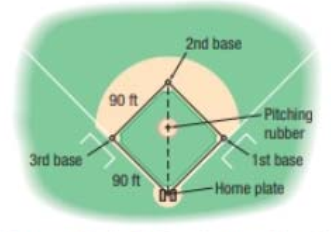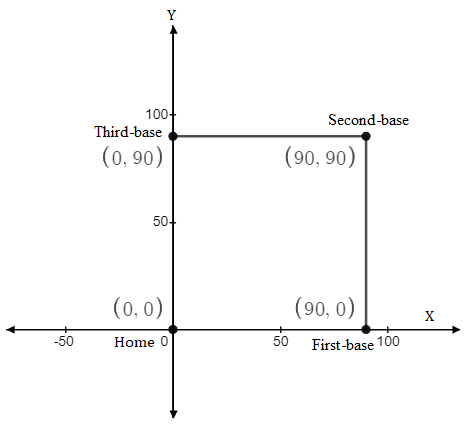
Concept explainers
Baseball Refer to Problem
What are the coordinates of first base, second base, and third base? Use feet as the unit of measurement.
If the right fielder is located at
If the center fielder is located at
(a)
The coordinate of first base, second base and third base in the feet as unit of measurement.
Answer to Problem 61AYU
Solution:
The coordinate of first base is
Explanation of Solution
Given Information:
A major league baseball “diamond” is square with
A rectangular co-ordinate system on a major league baseball is diamond. The origin is at home plate, the positive

Explanation:
As the home plate is at the origin of the rectangular coordinate then the coordinate of the home plate is origin that means
The first base is at a distance of
The second base is at a distance of
The third base is at a distance of
The below figure shows all the vertices of the baseball diamond:

(b)
To calculate: The distance from the right fielder to second base where the right fielder is located at
Answer to Problem 61AYU
Solution:
The distance between the right fielder to second base is
Explanation of Solution
Given Information:
A major league baseball “diamond” is square
A rectangular co-ordinate system on a major league baseball is diamond. The origin is at home plate, the positive

Formula used:
The distance formula: The distance between two points
Calculation:
From figure and part (a),
Thesecond base located at the
The right fielder is located at the
The distance between the right fielder to second base is
By using the distance formula
Therefore, the distance between the right fielder to second base is approximately
(c)
To calculate: The distance from the center fielder to third base, where the center fielder is located at
Answer to Problem 61AYU
Solution:
The distance between the center fielder to third base is approximately
Explanation of Solution
Given Information:
A major league baseball “diamond” is square
A rectangular co-ordinate system on a major league baseball is diamond. The origin is at home plate, the positive

Formula used:
The distance formula: The distance between two points
Calculation:
From figure and part (a),
Thethird base located at the
The center fielder is located at
The distance between the center fielder to third base is
By using the distance formula
Therefore, the distance between the center fielder to third base is approximately
Chapter 1 Solutions
Precalculus
Additional Math Textbook Solutions
Elementary Statistics (13th Edition)
A First Course in Probability (10th Edition)
A Problem Solving Approach To Mathematics For Elementary School Teachers (13th Edition)
Elementary Statistics
College Algebra (7th Edition)
- Consider the function f(x) = x²-1. (a) Find the instantaneous rate of change of f(x) at x=1 using the definition of the derivative. Show all your steps clearly. (b) Sketch the graph of f(x) around x = 1. Draw the secant line passing through the points on the graph where x 1 and x-> 1+h (for a small positive value of h, illustrate conceptually). Then, draw the tangent line to the graph at x=1. Explain how the slope of the tangent line relates to the value you found in part (a). (c) In a few sentences, explain what the instantaneous rate of change of f(x) at x = 1 represents in the context of the graph of f(x). How does the rate of change of this function vary at different points?arrow_forward1. The graph of ƒ is given. Use the graph to evaluate each of the following values. If a value does not exist, state that fact. и (a) f'(-5) (b) f'(-3) (c) f'(0) (d) f'(5) 2. Find an equation of the tangent line to the graph of y = g(x) at x = 5 if g(5) = −3 and g'(5) = 4. - 3. If an equation of the tangent line to the graph of y = f(x) at the point where x 2 is y = 4x — 5, find ƒ(2) and f'(2).arrow_forwardDoes the series converge or divergearrow_forward
- Suppose that a particle moves along a straight line with velocity v (t) = 62t, where 0 < t <3 (v(t) in meters per second, t in seconds). Find the displacement d (t) at time t and the displacement up to t = 3. d(t) ds = ["v (s) da = { The displacement up to t = 3 is d(3)- meters.arrow_forwardLet f (x) = x², a 3, and b = = 4. Answer exactly. a. Find the average value fave of f between a and b. fave b. Find a point c where f (c) = fave. Enter only one of the possible values for c. c=arrow_forwardplease do Q3arrow_forward
- Use the properties of logarithms, given that In(2) = 0.6931 and In(3) = 1.0986, to approximate the logarithm. Use a calculator to confirm your approximations. (Round your answers to four decimal places.) (a) In(0.75) (b) In(24) (c) In(18) 1 (d) In ≈ 2 72arrow_forwardFind the indefinite integral. (Remember the constant of integration.) √tan(8x) tan(8x) sec²(8x) dxarrow_forwardFind the indefinite integral by making a change of variables. (Remember the constant of integration.) √(x+4) 4)√6-x dxarrow_forward
 Calculus: Early TranscendentalsCalculusISBN:9781285741550Author:James StewartPublisher:Cengage Learning
Calculus: Early TranscendentalsCalculusISBN:9781285741550Author:James StewartPublisher:Cengage Learning Thomas' Calculus (14th Edition)CalculusISBN:9780134438986Author:Joel R. Hass, Christopher E. Heil, Maurice D. WeirPublisher:PEARSON
Thomas' Calculus (14th Edition)CalculusISBN:9780134438986Author:Joel R. Hass, Christopher E. Heil, Maurice D. WeirPublisher:PEARSON Calculus: Early Transcendentals (3rd Edition)CalculusISBN:9780134763644Author:William L. Briggs, Lyle Cochran, Bernard Gillett, Eric SchulzPublisher:PEARSON
Calculus: Early Transcendentals (3rd Edition)CalculusISBN:9780134763644Author:William L. Briggs, Lyle Cochran, Bernard Gillett, Eric SchulzPublisher:PEARSON Calculus: Early TranscendentalsCalculusISBN:9781319050740Author:Jon Rogawski, Colin Adams, Robert FranzosaPublisher:W. H. Freeman
Calculus: Early TranscendentalsCalculusISBN:9781319050740Author:Jon Rogawski, Colin Adams, Robert FranzosaPublisher:W. H. Freeman
 Calculus: Early Transcendental FunctionsCalculusISBN:9781337552516Author:Ron Larson, Bruce H. EdwardsPublisher:Cengage Learning
Calculus: Early Transcendental FunctionsCalculusISBN:9781337552516Author:Ron Larson, Bruce H. EdwardsPublisher:Cengage Learning





